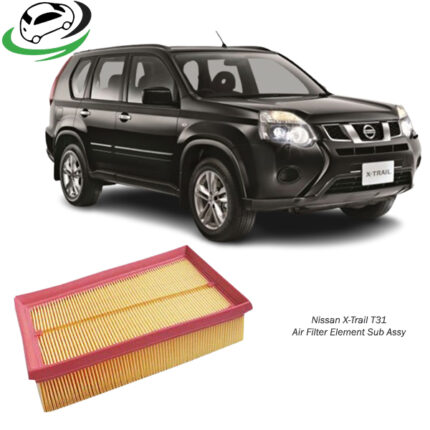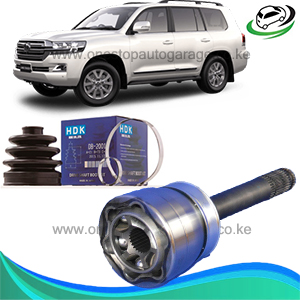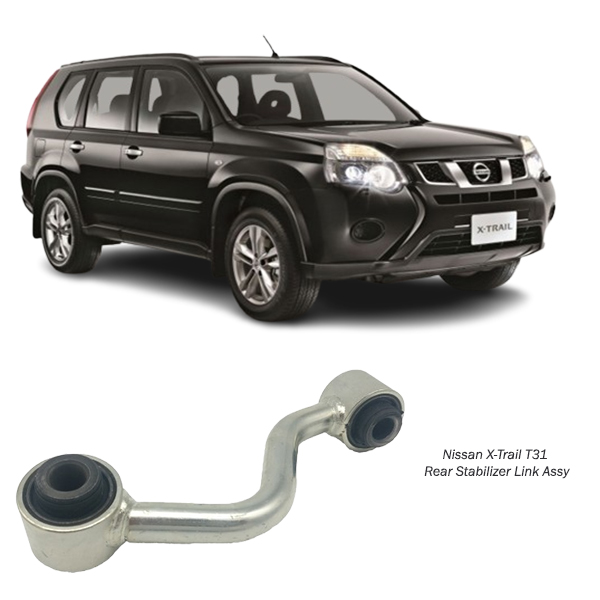-13%
Get Nissan X-Trail T31 Rear Left Stabilizer Link Assy LH 55619-JD00A in Kenya
The rear left stabilizer link assembly (LH) is a crucial component of a vehicle’s suspension system, ensuring stability and comfort during driving. This part, specifically installed on the left-hand side of the rear suspension, connects the stabilizer bar (also known as the sway bar) to the suspension components. Its primary role is to reduce body roll during cornering and provide a smooth and stable driving experience. This guide explores the function, construction, benefits, maintenance, and replacement considerations of the rear left stabilizer link assembly in detail.
What is a Rear Stabilizer Link Assembly (LH)?
The rear stabilizer link assembly, particularly on the left-hand side (LH), acts as a bridge between the vehicle’s stabilizer bar and the suspension. The stabilizer bar is a torsion spring designed to resist body roll during cornering, and the stabilizer link transmits the bar’s resistance to the suspension components.
The stabilizer link assembly consists of the following parts:
- Metal Rod or Shaft: A solid or hollow shaft that forms the main body of the link.
- Ball Joints: Flexible joints at both ends, allowing movement in multiple directions.
- Bushings: Rubber or polyurethane components that cushion the connection points, reducing vibration and noise.
- Mounting Hardware: Bolts and nuts secure the assembly to the stabilizer bar and suspension arm.
The left-hand (LH) designation simply refers to its installation on the left side of the vehicle’s rear axle.
Functions of the Rear Left Stabilizer Link Assembly
- Minimizing Body Roll
During cornering or sharp turns, the vehicle’s body tends to lean outward due to centrifugal force. The stabilizer link ensures that the stabilizer bar effectively counteracts this roll, keeping the vehicle level. - Improving Handling
The assembly helps maintain consistent tire contact with the road surface, improving traction and steering response. This is particularly important during sudden maneuvers or when driving on uneven terrain. - Enhancing Ride Comfort
By reducing the lateral movement of the vehicle body, the stabilizer link contributes to a smoother ride, minimizing discomfort for passengers. - Maintaining Suspension Geometry
It ensures that the suspension components work in harmony, preventing misalignment and uneven tire wear.
Construction and Materials
- Rod or Shaft
The main body of the stabilizer link is typically made of high-strength steel or aluminum. Steel offers durability and resistance to bending, while aluminum provides a lightweight alternative for better fuel efficiency. - Ball Joints
These are made from hardened steel and feature a protective coating to resist corrosion. The ball joints allow for rotational movement, accommodating the suspension’s dynamic range. - Bushings
Rubber bushings are common in standard vehicles, offering a balance of comfort and durability. Performance vehicles may use polyurethane bushings, which are stiffer and provide better handling but may transmit more vibration. - Protective Coatings
The entire assembly is often coated with corrosion-resistant materials, such as zinc or powder coating, to enhance its lifespan in harsh conditions.
Common Types of Rear Stabilizer Links
- Standard Stabilizer Links
These links are straightforward in design, suitable for most passenger vehicles. They offer a good balance of durability, performance, and cost-effectiveness. - Adjustable Stabilizer Links
Found in high-performance or modified vehicles, these links allow for adjustments in length, enabling fine-tuning of the suspension setup. - Heavy-Duty Stabilizer Links
Designed for off-road vehicles and trucks, these links are built to withstand extreme conditions and heavier loads.
Signs of a Failing Rear Left Stabilizer Link Assembly
- Clunking or Rattling Noises
Worn or damaged ball joints or bushings can cause clunking noises when driving over bumps or during cornering. - Poor Handling
A noticeable increase in body roll, reduced steering responsiveness, or instability during turns can indicate a failing stabilizer link. - Uneven Tire Wear
If the stabilizer link is damaged, it can lead to misalignment of the suspension system, causing uneven wear on the tires. - Visible Damage
Inspect the stabilizer link for signs of wear, such as cracked bushings, rust, or a bent rod. - Reduced Ride Comfort
A failing stabilizer link may compromise the suspension’s ability to absorb shocks, leading to a harsher ride.
Benefits of a Functional Rear Left Stabilizer Link Assembly
- Enhanced Safety
By maintaining vehicle stability during cornering, the stabilizer link reduces the risk of rollover accidents. - Improved Driving Experience
A properly functioning stabilizer link provides a smoother and more comfortable ride, enhancing overall driving pleasure. - Prolonged Tire Life
Ensuring even tire contact with the road reduces wear and extends the life of the tires. - Protection for Other Suspension Components
A stable suspension system reduces stress on other components, such as the shocks and struts, minimizing repair costs.
Maintenance Tips for the Rear Left Stabilizer Link Assembly
- Regular Inspection
Periodically inspect the stabilizer link for visible signs of wear, such as damaged bushings, rust, or loose connections. - Lubrication
Some stabilizer links feature grease fittings. Regularly lubricating these fittings can prolong the life of the ball joints. - Avoid Overloading
Excessive loads can stress the suspension system, including the stabilizer links, leading to premature wear. - Timely Replacement of Worn Parts
Replace worn or damaged stabilizer links promptly to prevent further damage to the suspension system.
Replacing a Rear Left Stabilizer Link Assembly
- Tools Needed
- Socket set and wrenches
- Jack and jack stands
- Torque wrench
- Penetrating oil (for rusty bolts)
- Steps
- Lift the Vehicle: Securely lift and support the rear of the vehicle using a jack and jack stands.
- Remove the Old Link: Locate the stabilizer link and remove the nuts securing it to the stabilizer bar and suspension arm. Penetrating oil can help loosen rusted bolts.
- Install the New Link: Position the new stabilizer link and tighten the nuts to the manufacturer’s torque specifications.
- Check Alignment: Ensure the suspension components are properly aligned before lowering the vehicle.
- Test Drive: After installation, take the vehicle for a test drive to verify proper operation.
Choosing the Right Rear Left Stabilizer Link Assembly
- Compatibility
Ensure the replacement stabilizer link is compatible with your vehicle’s make, model, and year. - Material Quality
Choose a stabilizer link made from high-quality materials, such as hardened steel or aluminum, for durability and performance. - Brand Reputation
Opt for reputable brands that offer reliable warranties and are known for producing quality suspension components. - Application
Consider your driving habits and conditions. For example, if you drive off-road, a heavy-duty stabilizer link may be more suitable.
Conclusion
The rear left stabilizer link assembly (LH) is a small but vital component of the suspension system, ensuring stability, comfort, and safety during driving. Its role in minimizing body roll, improving handling, and maintaining suspension geometry underscores its importance. Regular maintenance, timely replacement, and selecting the right part can ensure optimal performance and longevity. Whether you’re a daily commuter or an off-road enthusiast, taking care of your stabilizer links will keep your vehicle safe and enjoyable to drive
Follow us on Facebook for more parts.



